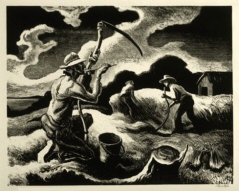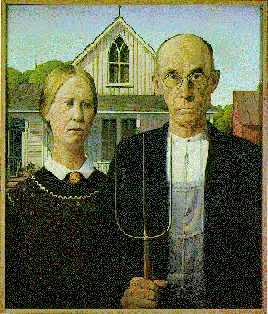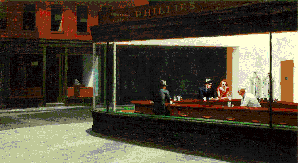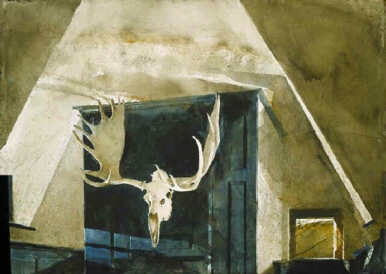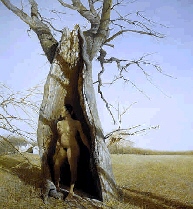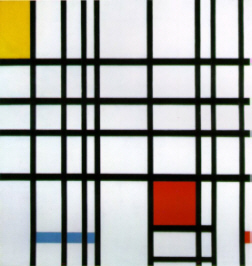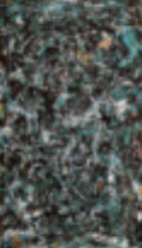Modern (American) Art
Part Two
The Twentieth Century
began with continued development of naturalism and realism
Thomas Hart Benton (1889-1975)
A regionalist
Created a rugged naturalist style
Often depicted depression-era American workers
Benton's "Island Hay," 1945
Grant Wood
(1892-1942)
"American Gothic," 1930
regionalist; taught public school, college
Created what is probably the most famous painting in the US
See more paintings by Wood here.
Edward Hopper
(1882-1967)
Expressed
loneliness, emptiness of city life
More modern
in style
by far Hopper's
most famous picture, "Nighthawks,"
1942
"I didn't
see it as particularly lonely . . . . Unconsciously, probably, I
was painting the loneliness of a large city."
See more paintings by Hopper at the Artchive.
Andrew Wyeth
(1917- )
"Big Game,"
1987
realist
Known for
painting objects and people in rural Pennsylvania, Maine
Abstract
Expressionism
Abstract expressionism grew
out of . . .
began in the 1940s
The dominant form of painting
around the world since WWII
Centered in NYC; also called
the New York School
The painters'
styles are extremely diverse, joined more by conceptual background than
by similarities in image
Abstract
art, developed
by Russian artist Wassily Kandinsky
(1866-1944) (see the Artchive), known for brilliant color, complex design
Kandinsky
taught at the Bauhaus school in Berlin and formed
Der Blaue Reiter
group of artists
another
artist famous for abstraction is Piet Mondrian
Mondrian's
"Composition with Red, Yellow and Blue," 1921
See more paintings by Mondrian at the Artchive.
and .
. .
Surrealism,
based on the artist's representation of the subconscious, the spontaneous,
represented by
Max Ernst
(1891-1976)
See these
classically surrealist examples
Marcel
Duchamp (1887-1968)
"Fountain,"
1917, 1964
Rene Magritte
(1898-1967)
(see this
example, this
example, and this
example from this
page)
Salvador
Dalí (1904-1989)
See a large selection of his work here.
A leading
abstract
expressionist was
Jackson
Pollock (1912-1956)
Began as a regionalist
painter, student of Benton
Influenced by Mexican muralists
(Orozco, Rivera,
Siquieros);
see his "Blue (Moby Dick)" 1943, with
strong surrealist overtones
Developed "drip painting"
Employed by Works Projects Administration
(WPA), one of the New Deal programs pioneered by Franklin Roosevelt to
support artists during the Depression
Known for
action
painting, previously
the style of Lee Krasner,
Pollock's wife
a characteristic work made through drip painting, Pollock's "Full Fathom Five," 1947
"On the floor I am more at ease,
I feel nearer, more a part of the painting, since this way I can walk around
in it, work from the four sides and be literally 'in' the painting."
"Full Fathom Five is one of the earliest masterpieces
of Pollock's drip technique. The actual origins and initial development
of this technique have never been fully explained, except by reading back
from fuller photographic evidence produced about 1950, two or three years
after this work was painted. Like other practical breakthroughs in twentieth-century
painting, 'creative accident' seems likely to have played an important
part, as Pollock probed and tested methods of paint application which promote
the continuousness of line rather than the broken lines inevitable in the
constant reloadings and readjustments of conventional brushwork. His solution
was to pour from a can of domestic paint along a stick resting inside the
container, so that a constant 'beam' of pigment came into contact with
the canvas (which he left unstretched on the studio floor). The character
of the line was determined by certain physical and material variables that
could be combined in almost infinite permutations: the viscosity of the
paint (controlled by thinning and dilution); the angle and hence speed
of the pouring; and the dynamics of Pollock's bodily gestures, his sweep
and rhythm, especially in the wrist, arm and shoulder. 'Like a seismograph',
noted writer Wemer Haftmann 'the painting recorded the energies and states
of the man who drew it.' In addition Pollock would flick, splatter and
dab subsidiary colors on to the dominant linear configuration."
-- Jackson Pollock, 1947
--Nicolas Pioch, http://www.ibiblio.org
Also see Pollock's "Lavender Mist: Number 1, 1950"
Other action painters
Willem de
Kooning (1904-1997)
Also an action painter, though he created more recognizable images.
See some of de Kooning's work at the Artchive.
Mark Rothko (1903-1970)
known for color-field painting--painting with large fields of a single color.
See some of Rothko's work at the Artchive.
Robert Motherwell (1915-1991)
often combined color-field and action painting
See Motherwell's work at the Artchive.
>> Other Art of the Twentieth Century >>
|
|
|
|
|
